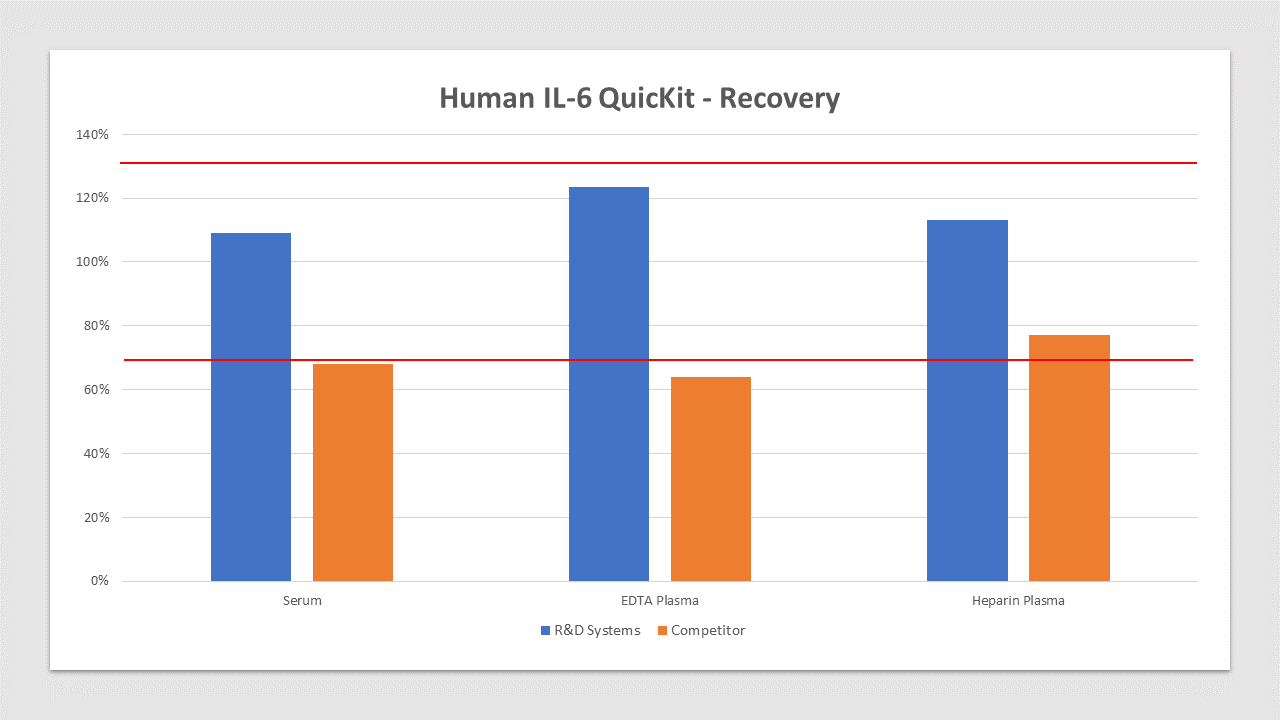Human IL-6 Quantikine QuicKit ELISA Summary
Product Summary
Precision
Cell Culture Supernates, Serum, EDTA Plasma, Heparin Plasma
| Intra-Assay Precision | Inter-Assay Precision | |||
|---|---|---|---|---|
| Sample | 1 | 2 | 1 | 2 |
| n | 20 | 20 | 10 | 10 |
| Mean (pg/mL) | 91.9 | 497 | 87.9 | 487 |
| Standard Deviation | 2.15 | 14.3 | 7.49 | 38.6 |
| CV% | 2.3 | 2.9 | 8.5 | 7.9 |
Recovery
The recovery of human IL-6 spiked to three different levels in samples throughout the range of the assay in various matrices was evaluated.
| Sample Type | Average % Recovery | Range % |
|---|---|---|
| Cell Culture Media (n=4) | 119 | 114-126 |
| EDTA Plasma (n=2) | 117 | 112-122 |
| Heparin Plasma (n=2) | 111 | 107-114 |
| Serum (n=2) | 106 | 96-115 |
Linearity
Scientific Data
 View Larger
View Larger
Human IL-6 QuicKit Spiked Recovery Competitor Comparison IL-6 is spiked at three known concentrations throughout the range of the assay and run to measure response of the spiked sample matrix. Serum recovery is 109% compared to 68% for the top competitor. Plasma recovery is 113% compared to 77% for the top competitor.
 View Larger
View Larger
Human IL-6 QuicKit Spiked Linearity Competitor Comparison IL-6 is spiked at high concentration in various matrices and diluted with appropriate Calibrator Diluent to produce samples with values within the dynamic range of the assay. The linearity is between 86%-107% compared to 111%-149% for the top competitor.
Product Datasheets
Preparation and Storage
Background: IL-6
Interleukin 6 (IL-6) is a pleiotropic, a-helical, 22-28 kDa phosphorylated and variably glycosylated cytokine that plays important roles in the acute phase reaction, inflammation, hematopoiesis, bone metabolism, and cancer progression. Mature human IL-6 is 183 amino acids (aa) in length and shares 39% aa sequence identity with mouse and rat IL-6. Alternative splicing generates several isoforms with internal deletions, some of which exhibit antagonistic properties. Cells known to express IL-6 include CD8+ T cells, fibroblasts, synoviocytes, adipocytes, osteoblasts, megakaryocytes, endothelial cells (under the influence of endothelins), sympathetic neurons, cerebral cortex neurons, adrenal medulla chromaffin cells, retinal pigment cells, mast cells, keratinocytes, Langerhans cells, fetal and adult astrocytes, neutrophils, monocytes, eosinophils, colonic epithelial cells, B1 B cells and pancreatic islet beta cells. IL-6 production is generally correlated with cell activation and is normally kept in control by glucocorticoids, catecholamines, and secondary sex steroids. Normal human circulating IL-6 is in the 1 pg/mL range, with slight elevations during the menstrual cycle, modest elevations in certain cancers, and large elevations after surgery.
IL-6 induces signaling through a cell surface heterodimeric receptor complex composed of a ligand binding subunit (IL-6 R alpha) and a signal transducing subunit (gp130). IL-6 binds to IL-6 Ra, triggering IL-6 Ra association with gp130 and gp130 dimerization. gp130 is also a component of the receptors for CLC, CNTF, CT-1, IL-11, IL-27, LIF, and OSM. Soluble forms of IL-6 Ra are generated by both alternative splicing and proteolytic cleavage. In a mechanism known as trans-signaling, complexes of soluble IL-6 and IL-6 Ra elicit responses from gp130-expressing cells that lack cell surface IL-6 Ra. Trans-signaling enables a wider range of cell types to respond to IL-6, as the expression of gp130 is ubiquitous, while that of IL-6 Ra is predominantly restricted to hepatocytes, monocytes, and resting lymphocytes. Soluble splice forms of gp130 block trans-signaling from IL-6/IL-6 Ra but not from other cytokines that use gp130 as a co-receptor.
IL-6, along with TNF-a and IL-1, drives the acute inflammatory response. IL-6 is almost solely responsible for fever and the acute phase response in the liver, and it is important in the transition from acute inflammation to either acquired immunity or chronic inflammatory disease. When dysregulated, it contributes to chronic inflammation in conditions such as obesity, insulin resistance, inflammatory bowel disease, arthritis, and sepsis. IL-6 modulates bone resorption and is a major effector of inflammatory joint destruction in rheumatoid arthritis through its promotion of Th17 cell development and activity. It contributes to atherosclerotic plaque development and destabilization as well as the development of inflammation-associated carcinogenesis.
Assay Procedure
These assays utilize an anti-tag coated microplate. Standards, samples, and controls are added to plate, followed by subsequent addition of an antibody cocktail. Following a 1 hour incubation, plates are washed and substrate is added and incubated for 20 minutes. Stop solution is then added and plates are read using a standard microplate reader.

Citations for Human IL-6 Quantikine QuicKit ELISA
R&D Systems personnel manually curate a database that contains references using R&D Systems products. The data collected includes not only links to publications in PubMed, but also provides information about sample types, species, and experimental conditions.
2
Citations: Showing 1 - 2
Filter your results:
Filter by:
-
LINC01094/SPI1/CCL7 Axis Promotes Macrophage Accumulation in Lung Adenocarcinoma and Tumor Cell Dissemination
Authors: Z Wu, X Bai, Z Lu, S Liu, H Jiang
Journal of Immunology Research, 2022-09-09;2022(0):6450721.
Species: Human
Sample Types: Cell Culture Supernates
-
4-octyl Itaconate�inhibits lipopolysaccharide (LPS)-induced osteoarthritis via activating Nrf2 signalling pathway
Authors: Q Zhang, X Bai, R Wang, H Zhao, L Wang, J Liu, M Li, Z Chen, Z Wang, L Li, D Wang
Journal of Cellular and Molecular Medicine, 2022-01-23;0(0):.
Species: Human
Sample Types: Cell Culture Supernates
FAQs
No product specific FAQs exist for this product, however you may
View all ELISA FAQsReviews for Human IL-6 Quantikine QuicKit ELISA
Average Rating: 5 (Based on 1 Review)
Have you used Human IL-6 Quantikine QuicKit ELISA?
Submit a review and receive an Amazon gift card.
$25/€18/£15/$25CAN/¥75 Yuan/¥2500 Yen for a review with an image
$10/€7/£6/$10 CAD/¥70 Yuan/¥1110 Yen for a review without an image
Filter by:
















